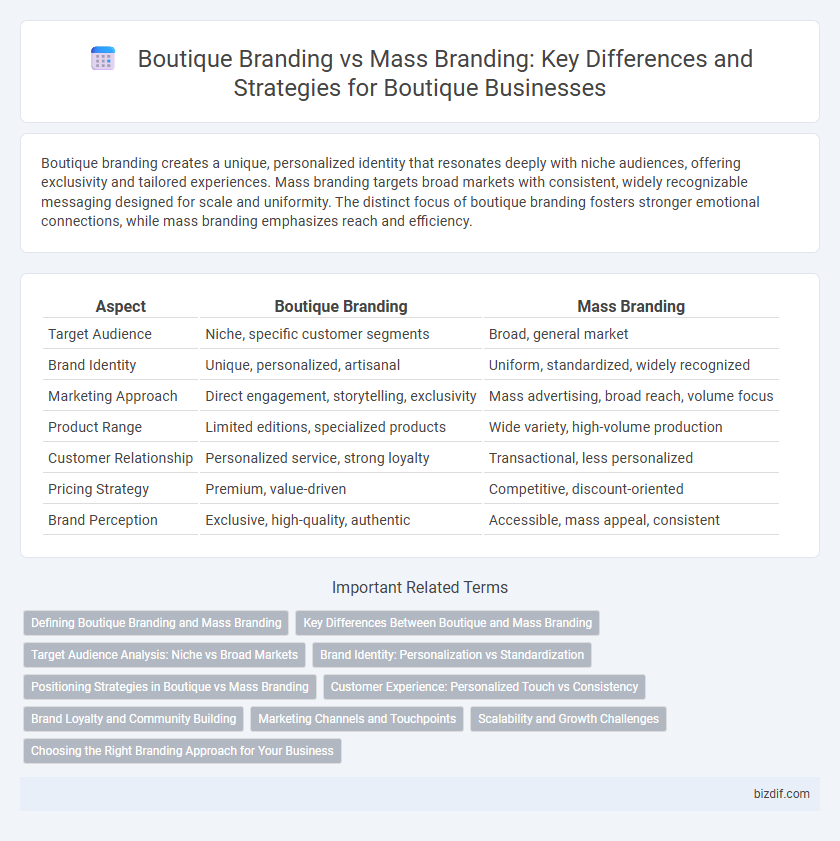Boutique branding creates a unique, personalized identity that resonates deeply with niche audiences, offering exclusivity and tailored experiences. Mass branding targets broad markets with consistent, widely recognizable messaging designed for scale and uniformity. The distinct focus of boutique branding fosters stronger emotional connections, while mass branding emphasizes reach and efficiency.
Table of Comparison
| Aspect | Boutique Branding | Mass Branding |
|---|---|---|
| Target Audience | Niche, specific customer segments | Broad, general market |
| Brand Identity | Unique, personalized, artisanal | Uniform, standardized, widely recognized |
| Marketing Approach | Direct engagement, storytelling, exclusivity | Mass advertising, broad reach, volume focus |
| Product Range | Limited editions, specialized products | Wide variety, high-volume production |
| Customer Relationship | Personalized service, strong loyalty | Transactional, less personalized |
| Pricing Strategy | Premium, value-driven | Competitive, discount-oriented |
| Brand Perception | Exclusive, high-quality, authentic | Accessible, mass appeal, consistent |
Defining Boutique Branding and Mass Branding
Boutique branding emphasizes a unique, personalized identity tailored to niche markets, often highlighting craftsmanship, exclusivity, and direct customer engagement. Mass branding targets a broad audience with standardized products, leveraging high-volume distribution and consistent messaging to build widespread brand recognition. The core difference lies in boutique branding's focus on differentiation and intimacy, while mass branding prioritizes scalability and uniformity.
Key Differences Between Boutique and Mass Branding
Boutique branding emphasizes personalized customer experiences, niche market targeting, and unique, artisan-crafted products that foster strong emotional connections. Mass branding relies on broad-market appeal, standardized messaging, and high-volume production to achieve widespread recognition and cost efficiency. Key differences include the scale of audience, customization level, and the depth of brand-customer relationships, with boutique brands prioritizing exclusivity and authenticity over mass-market reach.
Target Audience Analysis: Niche vs Broad Markets
Boutique branding targets niche markets through personalized messaging and tailored experiences that resonate deeply with specific customer segments, enhancing brand loyalty and perceived exclusivity. Mass branding aims at broad markets by utilizing standardized campaigns and wide-reaching channels to maximize brand recognition and appeal across diverse demographics. Effective target audience analysis is critical for boutique brands to identify unique customer needs, whereas mass branding relies on aggregate market data to optimize universal appeal.
Brand Identity: Personalization vs Standardization
Boutique branding emphasizes personalized brand identity through tailored designs, unique storytelling, and niche customer engagement, creating strong emotional connections with a specific audience. Mass branding relies on standardized brand identity with consistent messaging, broad appeal, and uniform product offerings to achieve high market penetration and recognition. Personalization in boutique branding drives loyalty and differentiation, while mass branding's standardization promotes efficiency and widespread brand awareness.
Positioning Strategies in Boutique vs Mass Branding
Boutique branding emphasizes niche positioning by targeting specific customer segments with unique, personalized experiences and exclusive product offerings, enhancing perceived value and customer loyalty. Mass branding focuses on broad market appeal through standardized messaging and wide distribution channels, aiming for high brand recognition and economies of scale. Positioning strategies in boutique branding leverage differentiation and emotional connection, whereas mass branding relies on consistency and extensive reach to maximize market penetration.
Customer Experience: Personalized Touch vs Consistency
Boutique branding excels in delivering a personalized customer experience by tailoring interactions and products to individual preferences, creating a strong emotional connection and higher customer loyalty. Mass branding prioritizes consistency across large customer bases, ensuring uniform quality and recognizable brand identity but often sacrifices personal engagement. The boutique approach leverages exclusivity and customization, while mass branding drives scalability and widespread trust through standardized experiences.
Brand Loyalty and Community Building
Boutique branding excels in creating strong brand loyalty by offering personalized experiences and fostering intimate connections with niche audiences, which mass branding often struggles to achieve due to its broad focus. This targeted approach enables boutiques to build passionate communities around shared values and unique identities, enhancing customer engagement and long-term retention. Mass branding prioritizes widespread appeal, but boutique strategies drive deeper emotional investment and sustained consumer advocacy.
Marketing Channels and Touchpoints
Boutique branding leverages highly targeted marketing channels such as social media influencers, niche blogs, and personalized email campaigns to create intimate and meaningful touchpoints with a specific audience. Mass branding utilizes broad channels like television, radio, and widespread online ads to reach a large, diverse customer base through generalized touchpoints. The effectiveness of boutique branding lies in its ability to foster strong emotional connections by delivering tailored content that resonates deeply with its audience.
Scalability and Growth Challenges
Boutique branding emphasizes unique, personalized experiences that foster strong customer loyalty but often faces scalability limitations due to higher production costs and niche market targeting. Mass branding leverages broad appeal and standardized products to achieve rapid growth and economies of scale, though it risks diluting brand differentiation. Scalability challenges for boutique brands include maintaining quality and exclusivity as they expand, while mass brands must balance growth with sustaining consumer engagement.
Choosing the Right Branding Approach for Your Business
Boutique branding emphasizes personalized customer experiences and niche market appeal, often leading to stronger brand loyalty and higher perceived value. Mass branding targets broad audiences with uniform messaging and large-scale distribution, optimizing for volume and brand recognition. Choosing the right branding approach depends on your business goals, target market specificity, and resource capacity to either foster deep customer connections or achieve widespread reach.
Boutique branding vs Mass branding Infographic

 bizdif.com
bizdif.com